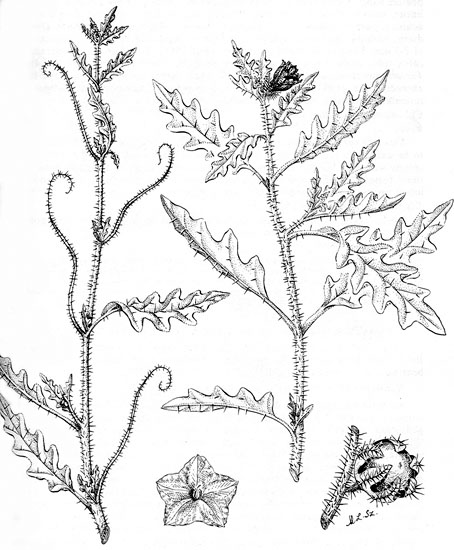 Line drawing of male (LHS) and fruiting plants (RHS) by M. Szent Ivany, J. Adelaide Bot. Gards 4 (1981). |
 Distribution map generated from Australia's Virtual Herbarium. |

Synonymy
Solanum carduiforme F. Muell., Fragm. Phytogr. Austral. 2: 163 (1861).
T: Nicholson River, Gulf of Carpentaria region, Qld, 21 Aug. 1856, F. Mueller s.n.; lecto: K; iso: MEL, fide D.E. Symon, J. Adelaide Bot. Gard. 4: 300 (1981).
Description
Erect, clonal herb or subshrub to 50 cm, male or female, pale green, the leaves densely pubescent with stellate hairs; prickles to 8 mm long, abundant on all parts.
Leaves lanceolate; lamina 5-11 cm long, 2-4 cm wide, concolorous, deeply lobed, the lobes oblong to broadly triangular, [more rarely, entire, narrowly ovate]; petiole 5-15 mm long.
Male plant: inflorescence many-flowered; rachis 3-12 cm long, pedicels 5 mm long; calyx 4-7 mm long, the lobes triangular, 1-3 mm long; corolla broadly stellate, 20-25 mm diam., purple; anthers 4-5 mm long. Fruiting plant: flowers solitary; pedicels short; calyx 9-12 mm long, enlarged in fruit, the lobes linear, unequal, 2-5 mm long; corolla broadly stellate, 20 mm diam., purple; anthers c. 4 mm long.
Berry globular, c. 2 cm diam., drying black. Seeds 1-2 mm long, brownish-black.
Distribution and ecology
A rare, inadequately known species, previously recorded only from the Lawn Hill area of north-western Qld, but now also recorded from the Bungle Bungle region and Prince Regent River area of northern WA. It is also listed in the NT Census for that state; see http://www.nt.gov.au/nreta/wildlife/plants/pdf/nt_checklist_oct_05.pdf
Grows on conglomerate rock formations.
Relationships
All of the dioecious members of the Dioicum group of subgen. Leptostemonum exhibit functional dioecy i.e. male flowers are borne on separate plants from what appear to be plants with bisexual or hermaphrodite flowers; while these bisexual flowers do produce pollen, it is inaperturate and does not germinate, making the flowers effectively female (Knapp et al.,1998).
Initial molecular studies by Martine et al. (2006) suggested that the two functionally dioecious species from Kakadu, S. asymmetriphyllum and the newly described S. sejunctum, formed a separate clade and had arisen separately from the other dioecious members of the Dioicum group, S. cunninghamii, S. cataphractum , S. dioicum, S. petraeum, S. carduiforme, S. tudununggae, S. vansittartense and S. leopoldense. T his initial DNA analysis involved sequencing of the ITS region of nuclear rDNA.
However further molecular analysis involving the trnK-matK gene region indicated that all of the functionally dioecious species form a single clade arising from the andromononoecious species of the group (Martine et al., 2009).
Many of these dioecious species remain undercollected and poorly understood and it is likely that some of these names will be changed with further work. For the presently circumscribed S. carduiforme, with its widely disjunct occurrences across three states, both molecular studies (Martine et al., 2006 & 2009) indicated that this is not a single species.
References: S.Knapp, V.Persson & S.Blackmore (1998). Pollen morphology and functional dioecy in Solanum (Solanaceae). Pl. Syst. Evol. 210:113-139.; Martine, C.T., D. Vanderpool, G.J. Anderson, and D.H. Les (2006). Phylogenetic relationships of andromonoecious and dioecious Australian species of Solanum subgenus Leptostemonum section Melongena: Inferences from ITS sequence data. Systematic Botany 31: 410-420; Martine, C.T., G.J. Anderson & D.H. Les (2006). Gender-bending aubergines; molecular phylogenetics of cryptically dioecious Solanum in Australia. Australian Systematic Botany 22: 107-120.
Notes
S. carduiforme has separate male and female/bisexual plants, with the flowers on female/bisexual plants being solitary while there are 12-28 flowers on a long rachis in the male plants.
For the presently circumscribed S. carduiforme, with its widely disjunct occurrences across three states, DNA studies indicate that they do not represent a single species.
Selected specimens
Qld: Lawn Hill Creek Gorge, T. Farrell 922 (AD). W.A.: 17 km S of Bungle Bungle outcamp, July 1984, K. Kenneally 9277 (AD, PERTH). N.T.: Sculthorpe Pound, Aug. 1985, P. Latz 10, 132 (AD, DNA).
Plant status, if any
Classified as Risk Code 2VC- (Briggs & Leigh, Rare or Threatened Australian Plants, 1995).
This species is listed as Vulnerable under the
It used to have the same status in the Northern Territory - www.nt.gov.au/nreta/wildlife/animals/threatened/pdf/plants/Solanum_carduiforme_DD.pdf
but now, though it is still Commonwealth listed, it is not considered to be threatened in NT - see www.nt.gov.au/nreta/wildlife/animals/threatened/specieslist.html#plants
A conservation advice for the species can be downloaded at www.environment.gov.au/biodiversity/threatened/species/pubs/18544-conservation-advice.pdf
From the web
A fact sheet for S. carduiforme as a threatened species in the Northern Territory can be downloaded at http://www.nt.gov.au/nreta/wildlife/animals/threatened/pdf/plants/Solanum_carduiforme_DD.pdf This fact sheet indicates the lack of information there is about it.
A conservation advice for the species can be downloaded at http://www.environment.gov.au/biodiversity/threatened/species/pubs/18544-conservation-advice.pdf
Further information and links for this species can be found on the Solanaceae Source site.